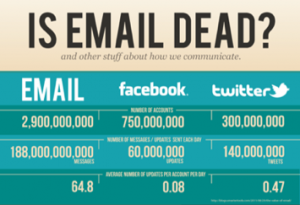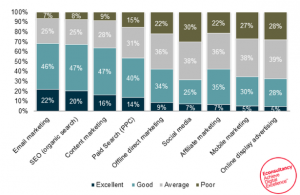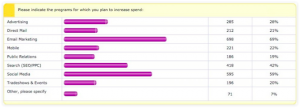Apr
2015
Why should small businesses invest in e-mail marketing rather than social media
But, first… what is E-mail Marketing and Social Media?
Email Marketing
E-mail is a direct form of permission-based CRM (customer relationship management) within marketing that enables a message(s) to be sent to a group of potential or existing customers via email, in order to start a conversation and or relationship between the company and customers (Social Media Today, 2014).
Social media
According to Oxford Dictionaries (2015) social media is; websites and applications that enable users to create and share content or to participate in social networking. These websites and applications include (to name a few): Twitter; Facebook; Pintrest; Linkedin and YouTube.
Benefits of Email to Businesses…
Often email marketing is overlooked due to the fine line between effective email marketing and spam marketing, the perceived demise of email as an effective way of reaching customers as well as common misconceptions from Alchemy Worx (2014). However, email marketing is actually considered to be the most effective online-channel for ROI (return on investment) (Charlton, 2014: Littlechild, 2014). Emails create impressions that lead to sales through other routes from the email (Middleton-Hughes, 2012) and are useful at telling companies the digital story of the customers, and as a result 85% of marketers cite email as the most effective lead-generation tactic (Social Media Today, 2014).
Ratings for the best digital channels of ROI
Attention has been taken away from the more traditional approach of email marketing, as companies adhere to the rise of social media with the digital revolution. However, often there is a considerable lack of understanding of social media according to DeMers (2014). Even so, social media has been shown to have positive effects on perceived brand recognition, brand loyalty and an improvement of the overall customer experience. Email, though, is said to improve customer communications and loyalty long-term (Bustos, 2015).
Email has always been a simple, easy to use and non-glamorous marketing tool. In fact, the rise of social media has largely built on the email experience by adding more features and offering more interactivity (Idugboe, 2015). But still you might be thinking… is email dead?
 … Click here to view the infographic in full, and more information on the role/importance of email…
… Click here to view the infographic in full, and more information on the role/importance of email…
No! Email is still king (Middleton-Hughes, 2012) and, is not dead!
A study conducted showed that email marketing is intended to receive the most spending from emarketers as the primary source of online marketing: as many as 69% marketing programs indicated a strong preference for email marketing as compared to 59% who opted for social media, as indicated below (Idugboe, 2015).
Social Media offers many ways to pursue innovative marketing techniques on a multitude of platforms – online video promotions (YouTube), audio podcasts, Fan Pages (Facebook), tweets and pins (Twitter and Pintrest). It allows companies to reach out to a large number of people on different networks in different walks of life.
However, in saying this, for small companies, with limited resources, email marketing is the way to go. Although there are no costs associated with purchasing and running social media per se, it costs companies to hire or require employees to continually monitor their associated social media sites, which impacts on time and financial restraints (Mohammadi, Malekian, Nosrati, & Karimi, 2013). On the other hand, businesses can set-up email host suites that ping out emails on a regular basis/occasion, this also allows emails to be measurable through analytical programmes via: bounce, delivery, click and conversion rates (Rospigliosi, 2014).
Email marketing as a whole is generally a less taxing process than social media maintenance, with less responsibility (Idugboe, 2015) low set-up costs (Ellis-Chadwick & Doherty, 2012), and has flexibility across platforms (Rospigliosi, 2014), which makes it quick and easy for small businesses to implement. However, despite these benefits ‘businesses are slow to adopt to email marketing practises’, and mistakenly are intimidated by the phrase ’email marketing’ itself (Mohammadi, Malekian, Nosrati, & Karimi, 2013) due to the perception of needing to be a digital marketing expert to implement an email marketing campaign.
The overall customer experience is better for customers with email marketing due to the fact that it is able to provide easy individual personalisation and interactivity (that often invites immediate respond action) (Rospigliosi, 2014; Ellis-Chadwick & Doherty, 2012).
As well as these benefits, email is ranked as the #1 communication channel by consumers for initial introduction to a product/service, learning about a product/service, and post-purchase follow-up about a product/service. This leads to higher conversion rates (at least 3x as high as social media conversion rates) (Social Media Today, 2014), and it is generally easier to keep storable information on customers (for CRM databases) than from social media sites, due to its data driven nature, which also allows emails to be highly focused and targeted as a result (Amprewave Media, 2015: Shout it out Design, 2015; Rospigliosi, 2014).
Email offers greater exposure than other channels, such as social media, as it waits in the inbox, and has higher exposure than blogs and social media platforms (Amprewave Media, 2015).
However, like anything, email marketing also has its downfalls…
The frequency of emails is a topic that always arises – messages that are too frequent can be deemed annoying, which can prove hard for marketeers to know exactly when to send their emails and also lead customers to believe that an email is ‘spam’ (Savvy SME, 2013), which can subsequently affect companies website rankings and reputation amongst customers. Email marketing often can disengage readers, leading to un-subscriptions and the risk of ultimately alienating any remaining customers (Savvy SME, 2013). However, emails are often deleted before being opened, therefore reducing the opportunity to gain new customers (Email Lists, 2011).
However, despite email being a superior channel, social media and email marketing can work hand-in-hand in an integrated way. Many referral campaigns and incentive-based promotions have benefited from the combo of Email + Social Media Marketing (Rospigliosi, 2014; Idugboe, 2015).
In any case, email marketing is trial and error process, the advantages and disadvantages will only be truly applicable if research is conducted on the audience and tested for success or failure through A and B testing. Take a look at this beginners site to understand the testing and the impact on conversion rates – http://bit.ly/1Oagyxw.
References
Alchemy Worx (2013) Debunking the 7 myths of email marketing – Infographic [Online] <http://www.alchemyworx.com/emailworx/2013/strategy/subject-lines/debunking-the-7-myths-of-email-marketing-–-infographic> [accessed 1 March 2015]
Amprewave Media (2015) Build your audience with email marketing [Online] <http://www.amprewave.com/content-marketing/build-your-audience-with-email-marketing/> [accessed 2 February 2015]
Charlton, G. (2014) ‘Email remains the best digital channel for ROI’. Econsultancy, 31 March 2014. [Online] <https://econsultancy.com/blog/64614-email-remains-the-best-digital-channel-for-roi/> [accessed 20 January 2015]
DeMers, J. (2014) ‘The top 10 benefits of social media marketing’. Forbes. 8 November 2014 [Online] <http://www.forbes.com/sites/jaysondemers/2014/08/11/the-top-10-benefits-of-social-media-marketing/> [accessed 2 March 2015]
Ellis-Chadwick, F., & Doherty, N. F. (2012) Web advertising: The role of e-mail marketing. Journal of Business Research. Vol. 65, No. 6, p843-848
Email Lists (2011) Email marketing: Advantages and disadvantages [Online] <http://email-lists1.com/email-marketing-advantages-and-disadvantages.html> [accessed 12 February 2015]
Idugboe, D. (2015) Why you shouldn’t abandon email marketing for social media. Smedio [Online] <http://www.smedio.com/why-social-media-is-yet-to-destroy-email-marketing/> [accessed 2 March 2015]
Kiss Metrics (2105) A beginner’s guide to A/B testing: Email campaigns that convert [Online] <https://blog.kissmetrics.com/ab-testing-email-campaigns/> [accessed 2 March 2015]
Littlechild, D. (2014) ‘Email marketing best practise guide’. Econsultancy. 14 March 2014 [Online] <https://econsultancy.com/reports/email-marketing-best-practice-guide> [accessed 12 February 2015]
Middleton-Hughes, A. (2012) ‘Why email marketing is king.’ Harvard Business Review. 9 August 2012 <https://hbr.org/2012/08/why-email-marketing-is-king> [accessed 9 February 2015]
Mohammadi, M., Malekian, K., Nosrati, M., & Karimi, R. (2013). Email Marketing as a Popular Type of Small Business Advertisement: A Short Review. Australian Journal of Basic and Applied Sciences. Vol. 7 (Issue 4), p786-790
Oxford Dictionaries (2015) Definition of social media [Online] <http://www.oxforddictionaries.com/definition/english/social-media> [accessed 2 March 2015]
Rospigliosi, A. (2014) ‘Email Marketing’ [Lecture notes] Brighton: University of Brighton Business School, unpublished
Savvy SME (2013) What are the advantages and disadvantages of email marketing? [Online] <https://www.savvysme.com.au/article/8-what-are-the-advantages-and-disadvantages-of-email-marketing> [accessed 10 January 2015]
Small Business (2015) Advantages and disadvantages of email marketing [Online] <http://smallbusiness.chron.com/advantages-disadvantages-email-marketing-3475.html> [accessed 14 January 2015]
Shout it out Design (2015) Top 10 advantages of email marketing [Online] <http://shoutitoutdesign.com/top-10-advantages-of-email-marketing/> [accessed 25 January 2015]
Social Media Today (2014) Attraction 101: Content marketing [e-book] Available at <http://www.socialmediatoday.com/sites/default/files/ebook_pdfs/actonebook-attraction101-dec2014.pdf> [accessed 12 January 2015]



